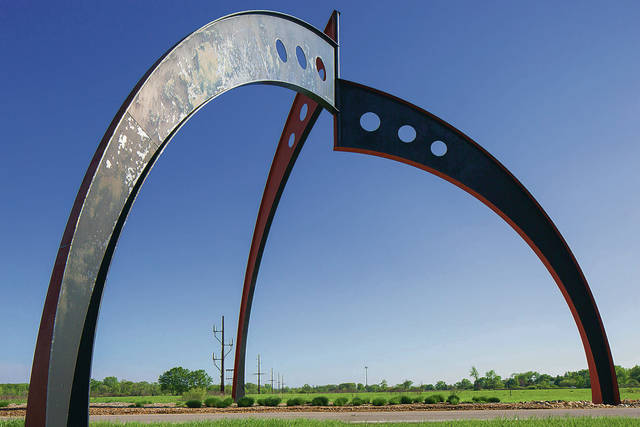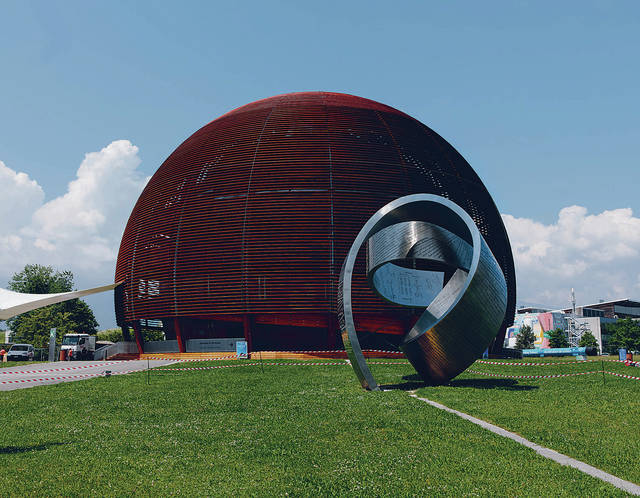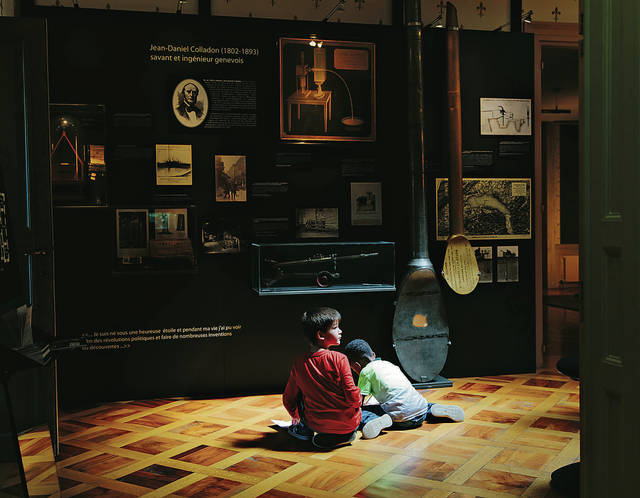Colliders, sundials and wonder: When science is your destination

NEW YORK TIMES
“Broken Symmetry” is a sculpture on the grounds of Fermilab, a national laboratory of the Department of Energy in Batavia, Ill.

NEW YORK TIMES
An exhibition in the Globe of Science and Innovation at CERN, the European Organization for Nuclear Research, in Geneva, Switzerland. Arguably the world’s most famous science facility, CERN is such a popular travel destination that free tours are often snapped up within seconds of being released.

NEW YORK TIMES
The Globe of Science and Innovation is a key feature at CERN, the European Organization for Nuclear Research, in Geneva, Switzerland.

NEW YORK TIMES
Children take in an exhibit at the Museum of the History of Science, in the La Perle du Lac park in Geneva. Occupying a 19th century villa originally built for Parisian bankers, the museum is a lavish setting for collections of science instruments dating to the 17th and 18th centuries.




Towering clouds threatened rain as I biked near the French-Swiss border. My sturdy Velo de Ville rolled over every type of surface and complained only when I steered it into runnels of mud. The trail meandered past dormant vineyards, through forests and fields of cabbage, and under the watchful eye of a hawk. At one point I stopped to walk through an old cemetery and found Roman ruins.
The whole morning was so moody and atmospheric that often I forgot the world’s largest machine lay several hundred feet below. But then the trail curved in a way that evoked the Large Hadron Collider, the reason for my visit to the outskirts of Geneva. I had just begun a weeklong trip focused on science, and my first stop was the particle collider at CERN, the European Organization for Nuclear Research. It houses the 17-mile-long ring that is arguably the world’s most famous science facility.
In fact, CERN is so popular that free tours are often snapped up within seconds of being offered. After monitoring CERN’s website for about two months, I finally found open spots at the end of January, which luckily coincided with modest winter airfares to Europe. So I booked a flight and started brushing up on my physics.
The Large Hadron Collider accelerates subatomic particles called protons to nearly the speed of light. At full speed, each proton zips around the collider 11,245 times every second while CERN scientists encourage them to smash into each other. Enormous detectors and worldwide computer networks comb through the debris of these collisions to try to find something novel and interesting.
In 2012, the Large Hadron Collider discovered the Higgs boson, a subatomic particle even smaller than a proton whose existence had long been theorized but never found. Actually proving that it existed gave physicists confidence that the standard model, the theory underpinning their discipline, was sound.
It also helped CERN become a tourist attraction, although that process had already begun when it was featured in Dan Brown’s novel “Angels &Demons,” as well as the sitcom “The Big Bang Theory.” Most of all, though, CERN drew the media spotlight in 2008 as the Large Hadron Collider was about to become operational. Several people not affiliated with CERN claimed there was a chance the collider could cause a world-destroying “micro black hole.” Although the claim was debunked, it helped CERN become a household name.
Don't miss out on what's happening!
Stay in touch with breaking news, as it happens, conveniently in your email inbox. It's FREE!
The morning before my visit to CERN, I biked along the Passeport Big Bang route, which traces the path of the underground ring. At a bike rental shop I grabbed a free trail map as well as a pamphlet that introduced the Large Hadron Collider through Tintin-like cartoon characters. Whoever at CERN put it together had a lot of fun devising multiple-choice questions like: “Which of these particles circulate in the LHC? a) simpletons b) protons c) croutons.”
After biking for several hours, I was dangerously close to missing my long-awaited tour slot, so I turned back after making it a quarter way around the ring. I raced back to the visitor center, locked up my rental bike and tried to wipe the countryside mud off my hands and pants.
The small welcome area was mobbed with visitors. Our guide was Klaus Batzner, a retired CERN particle physicist whose giddy excitement at the institution’s accomplishments more than made up for my limited comprehension of what he was saying. It wasn’t because of his accent. Particle physics is so complicated that it was like trying to understand a foreign language.
Our tour began with a presentation about CERN, and perhaps in a nod to lingering public awareness of the debunked micro black hole claim, we were told that during the visit we would receive less radiation than from dental X-rays. Thus reassured, we walked across the Geneva-bound tramline to the control room of the Atlas detector, one of the two detectors that discovered the Higgs boson. Next to the live video feeds of the detector was a plaque that summarized its lofty mission: “To advance human knowledge, to continue an endless quest to learn where we come from and why the Universe is as we see it today.”
The next morning, the rain that had been threatening finally arrived. It was cold, too, but I was fortified by strong coffee and the kind of buttery, flaky croissants that seem to occur by magic only in France and Switzerland. As I walked down to La Perle du Lac, Geneva’s lakefront park, rain clouds scudded grimly across the sky and the city felt still asleep. I had another visit planned to CERN that afternoon, but first I wanted to go back in time several hundred years, at the Museum of the History of Science.
The museum occupies a 19th-century villa originally built for Parisian bankers. Gold-filigreed walls and inlaid wood floors presented a striking contrast to the Calvinist practicality of Geneva buildings. Each room contained science instruments dating to the 17th and 18th centuries: hand-carved celestial globes, sundials, astrolabes, Crookes tubes and cathode ray tubes (which led to the discovery of X-rays), the first microscopes, oscillators and electric motors, as well as a vast array of glass eyes.
I could have spent the whole day in that small museum, mainly because of the beauty of the instruments. Made of brass, wood, mirrors and the first fumbling electric wires, these machines still thrummed with the discoveries they enabled. I peered through a 300-year-old microscope and imagined what it must have been like to see the once-invisible hairs on a flea for the first time.
The tram ride from the museum to CERN was short and efficient, 20 minutes that spanned several hundred years. As I walked to the visitor center, the rain clouds lifted to reveal a stunning vision on the nearby foothills. I could see the exact altitude where rain had turned to snow, like a cosmic line drawn through the trees.
At CERN, I met Ana Godinho, the Portuguese director of the institution’s education, communication and outreach programs, as well as her Belgian colleague Francois Briard. We discussed CERN’s becoming a worldwide household name, as well as the institution’s plans to build more facilities for visitors.
“The mystery around CERN works in our favor,” Godinho said. “It’s such a huge endeavor. Everything is big here, although we study tiny particles you can’t even see.” She marveled at the worldwide interest that engulfed CERN when the Higgs boson was discovered. Even nonphysicists were drawn to the adventure of trying to find it, she said.
Because CERN was in the midst of its annual winter shutdown, which usually occurs between the end of December and mid-March, Briard was able to take me down to see the actual Atlas detector deep below ground. I stood on a small observation deck and gaped at this several-stories-tall machine, its interior pulled open for maintenance. The detector was a vast network of mirrors and wires that looked like the blown-up photograph of an insect’s eye I had seen that morning at the museum. I took dozens of pictures, but none of them truly captured its scope and grandeur. At the end of 2018, the Large Hadron Collider will begin a 2-1/2-year shutdown for major upgrades. Tours to CERN will not be affected, and there even may be a bonus for those visiting in 2019 and 2020 because of potential opportunities to visit underground detectors, according to Briard.
As I finished my visit and walked out, my ears perked up at the familiar sound of U.S.-accented English. I peeked into CERN’s main hall and briefly listened to a presentation on DUNE, the Deep Underground Neutrino Experiment. This international collaboration will beam neutrinos back and forth through 800 miles of bedrock. I vowed to learn more, but instead that evening I shared a raclette-and-wine dinner with a gregarious Swiss couple, and promptly forgot about it.
Days later, though, I stumbled back upon the DUNE project in the Chicago suburbs. I was ending my week of science tourism with a visit to Fermilab, a national laboratory of the Department of Energy located in Batavia, Ill., about 45 miles west of the city. It houses the Tevatron, a predecessor of the Large Hadron Collider.
Like CERN, Fermilab is open to the public, conducting regular tours and also housing permanent exhibitions in its striking, midcentury Wilson Hall headquarters. While waiting for my tour to begin I discovered that the DUNE experiment is actually based in Fermilab. The facility’s proton accelerator will hurl neutrinos to a detector now being installed in Lead, South Dakota.
CERN is helping to build DUNE’s detectors, just like Fermilab helped build significant parts of the Large Hadron Collider.
I peeked into DUNE’s primary control room until it was time to begin the once-a-month free tour of the Tevatron’s 4.26-mile ring and DZero, its primary detector. During its operational lifetime from 1983 to 2011, the Tevatron was a primary site of international physics collaboration, just like CERN is today. Tevatron researchers discovered the top quark, another subatomic particle, and helped lay the groundwork for CERN’s discovery of the Higgs boson.
It’s been only seven years since the Tevatron last fired up its particle beam, but it seemed like a much longer time ago. Today the Tevatron is a time capsule underscoring the blisteringly rapid advances in science, machinery and computing. Our tour group walked down a stairwell illuminated by the buzz and flickering of fluorescent lights, and entered an area that smelled like my grandfather’s basement tool room.
Compared to CERN’s gleaming, space-age facility, where retina scanners are used to access the elevators leading down to the Large Hadron Collider, visiting the Tevatron is seriously old school. In the DZero control room, notepads and pencils still lay where they were left many years ago, the monitors looked like they were repurposed from the Apollo space program, and a spare Macintosh IIci (property of the U.S. government, according to a prominent sticker) sat in the corner. Next to it was a well-thumbed-through Fermilab phone directory from 2000.
During my week in Geneva and suburban Illinois, I visited an exuberant foreign country called science. It reminded me of so many reasons to travel — for sheer pleasure, to gain new perspectives and knowledge, or to feel more connected to someone you love. (I threw that last one in because my sister is a scientist.) However, I didn’t expect to be so inspired. Particle colliders and 300-year-old lab equipment revealed the better angels of our humanity.
An object from Geneva’s Museum of the History of Science lingered in my mind for weeks afterward. It was a slender tower made of copper, zinc, felt, glass and wood, and it gleamed with the promise of a new era. This was the world’s first battery, built by Italian physicist Alessandro Volta in the year 1800. Like everything else in the museum, its invention was a building block to arrive at the wonders contained in Fermilab, CERN and our everyday devices. The battery “domesticized electricity,” said the note accompanying Volta’s invention. I liked the image of this: a fierce lightning bolt tamed, patted on the head and placed into a container for future use.
Since then, I have imagined contemporaries of Volta, and the physicist himself, gazing at that first battery and reveling in the joy that comes from discovering new things, simply because it’s in our innermost nature to do so. It’s why I loved being a science tourist, visiting these places at the forefront of human knowledge. It was a rejuvenating tonic, one that left me excited about the future. I felt Volta’s joy too.
© 2018 The New York Times Company



